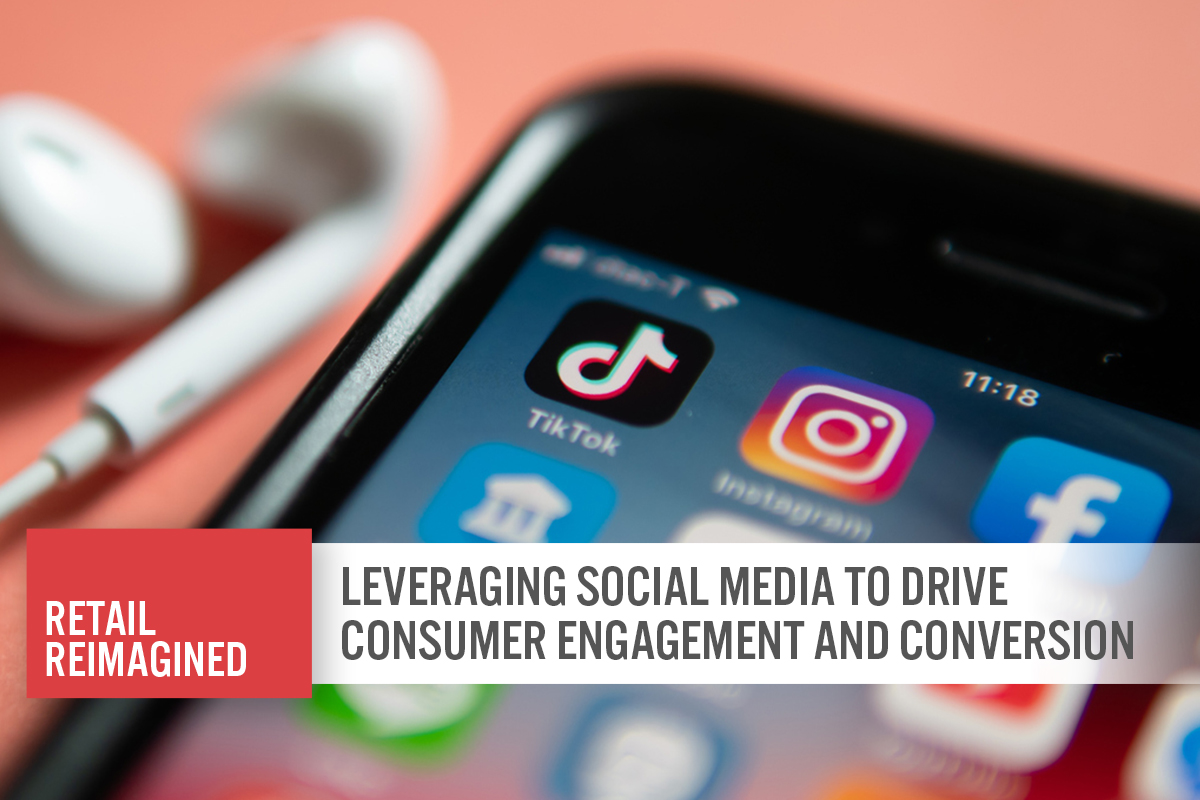
DIpil Das
What’s the Story?
Covid-19 has changed consumer behaviors, and retailers and brands have had to actively respond to these shifts—impacting how they operate and prompting retail firms to be more agile and adopt new channels, services and ways of selling. In our Retail Reimagined series, we offer a thematic outlook to the post-crisis world, identifying and discussing key retail trends that are likely to prevail and exploring how retail may be reimagined in response to shifts in demand and supply. [caption id="attachment_113523" align="aligncenter" width="700"] Source: Coresight Research[/caption]
In our second Retail Reimagined report, we highlight several social media strategies that brands and retailers could adopt to make the shopping process fun and seamless for customers—with a focus on the development of social commerce and influencer marketing. We will consider the use of livestreaming as a social sales channel separately, in the next report in this series.
Source: Coresight Research[/caption]
In our second Retail Reimagined report, we highlight several social media strategies that brands and retailers could adopt to make the shopping process fun and seamless for customers—with a focus on the development of social commerce and influencer marketing. We will consider the use of livestreaming as a social sales channel separately, in the next report in this series.
Why It Matters: Increased Reliance on Digital Channels
With the coronavirus pandemic having caused many nonessential businesses to temporarily shut down, retailers had to adjust their digital strategies to stay connected with customers—including by adapting their social media presence. We expect that this shift to online engagement will continue after the pandemic eases. There are currently around 249.7 million social media users in the US—equivalent to 75.5% of the total population—according to Statista estimates. On average, each user will spend an average of 80 minutes per day on social media through 2020, according to a revised estimate by market research firm eMarketer—representing an increase of six minutes over the pre-coronavirus estimate, partly due to users spending more time at home during lockdowns. Brands and retailers often use social media as a marketing channel to showcase their products. Around 49% of the 200 retail executives surveyed by content marketing platform Stackla in 2019 said that increased visibility for their products is a benefit they have realized via social commerce. The survey also found that around 63% of retailers work with influencers, including celebrities and key opinion leaders (KOLs), who publish posts on product experiences and details about product features. Leveraging influencers is an important subset of social commerce, drawing interest from consumers and encouraging them to purchase items based on KOL recommendations.Looking Beyond the Crisis
In the post-crisis world, we expect that brands and retailers will further use social media to engage more closely with consumers, such as by leveraging influencers, as well as working to make the shopping journey more seamless via social media channels. Making Social Shopping as Seamless as Possible With businesses increasingly turning to e-commerce to sell products, we expect social media platforms to add further functionality to improve their shoppability—enabling purchases to be made directly through the platforms, rather than redirecting shoppers to third-party sites. For instance, platforms will enable brands and retailers to create more clickable content by tagging images, videos and social feeds, making the purchase process a one-click endeavor. In March 2019, Instagram launched checkout options on its platform to facilitate in-app shopping. Consumers’ desire for seamless shopping via social media platforms is evident: According to a Coresight Research 2019 survey that explored the use of social media by US shoppers, 77.6% of US consumers who use social media for product research said they would occasionally or often give up making a purchase due to a lack of in-built functionality (see Figure 1). [caption id="attachment_113305" align="aligncenter" width="700"]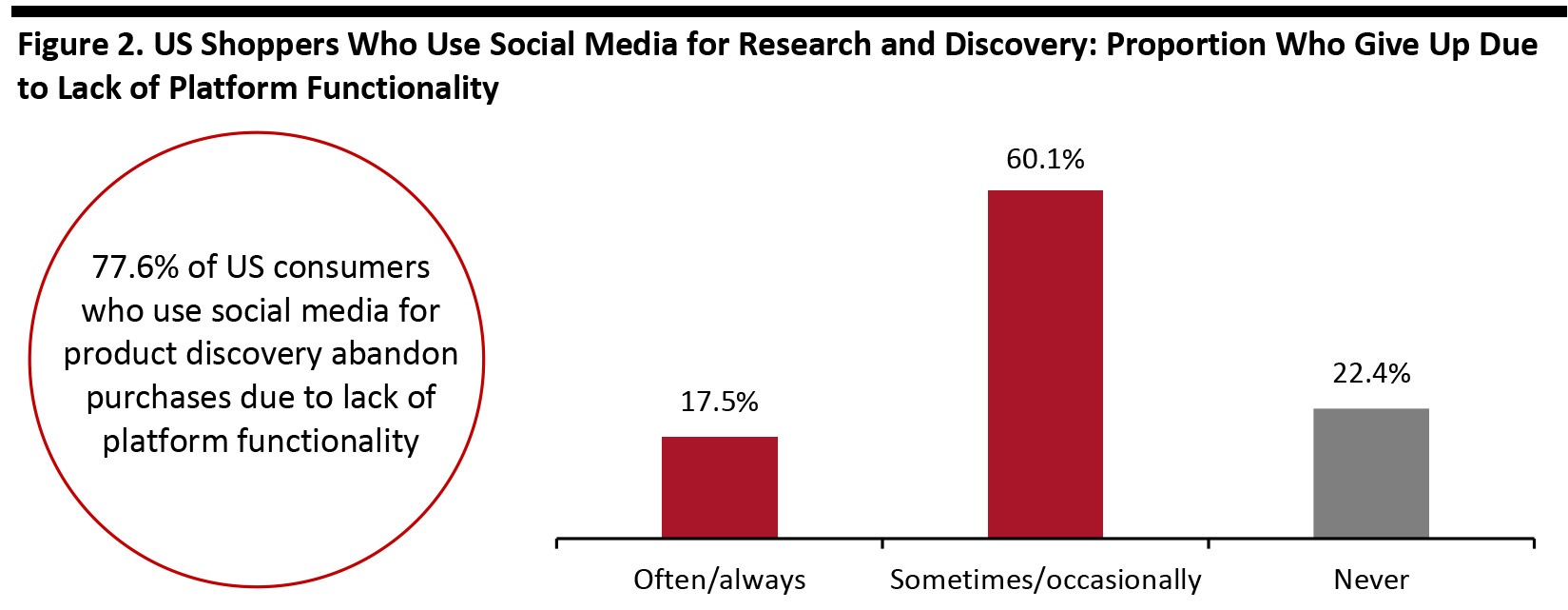 Base: 851 US Internet respondents aged 18+ who use social media to discover products or research purchases as part of the shopping process, surveyed in November 2019
Base: 851 US Internet respondents aged 18+ who use social media to discover products or research purchases as part of the shopping process, surveyed in November 2019 Source: Coresight Research [/caption] In line with efforts to facilitate seamless shopping through social media, we expect that platforms will integrate augmented reality (AR) technology to enhance consumers’ experiences of products before they make purchasing decisions. We have already seen Sephora leverage Facebook’s AR features for this purpose: Customers can virtually try on different makeup products. Facebook and Instagram have plans to offer more comprehensive AR features to different brands in the future. Leveraging Social Media Influencers To Drive Engagement We expect that brands and retailers will increase their influencer marketing budgets, with a particular focus on influencers on Instagram. Our social commerce survey found that social media influencers have an impact on the purchasing decisions of US shoppers—and Instagram is outperforming other platforms in this respect: Some 23.6% of Instagram shoppers who follow influencers on the platform stated that their shopping is “often or always” affected by influencers or celebrities on Instagram, compared to the 19.7% of general social media shoppers who follow influencers. The greater impact of influencers on Instagram is very likely due to its focus on visual content—images and videos—which users may find more engaging and personable than the text-based nature of other social media platforms. Fully 80% of US consumers would rather watch a live video from a brand than read a blog, according to Livestream, a Vimeo-owned event-sharing platform—indicating consumers’ preference for live video and its importance as a marketing and distribution tool. (We will discuss livestreaming in a separate, future report in this series.) Recognizing the power of key opinion leaders (KOLs) and celebrities in influencing consumer behavior, brands and retailers in the US have started to leverage influencers in their marketing strategies. For example, Birchbox partnered with four YouTube influencers to create sponsored holiday-themed videos in 2019 that featured the Birchbox holiday box. We expect more brands and retailers will leverage influencer marketing in the post-crisis world, with the influencer marketing industry estimated to reach $15 billion by 2022, according to Business Insider Intelligence. Chiara Ferragni is a global fashion influencer with over 20.5 million followers on Instagram. She has become famous for her fashion-forward style and ability to pair looks together—such as a high-end luxury top with denim cutoffs—which peaks consumer interest. Her fashion collaborations have included luxury brands Dior, Ermenegildo Zegna and Louis Vuitton. She also has her own Chiara Ferragni Collection, which includes clothing and footwear. Ferragni has gained many partnerships and collaborations through her energetic personality and style, which consumers find engaging. In March 2020, Ferragni teamed up with Oreo Double cookies to design limited-edition packaging. She announced the partnership through an Instagram post, posting previews of the product and driving buzz on social media prior to its launch. The collaboration between the brand and the entrepreneur also launched the “Oreo by Chiara Ferragni” capsule fashion collection with four limited-edition pieces—with Ferragni stating that the proceeds would be donated to the fight against the coronavirus pandemic. [caption id="attachment_113306" align="aligncenter" width="700"]
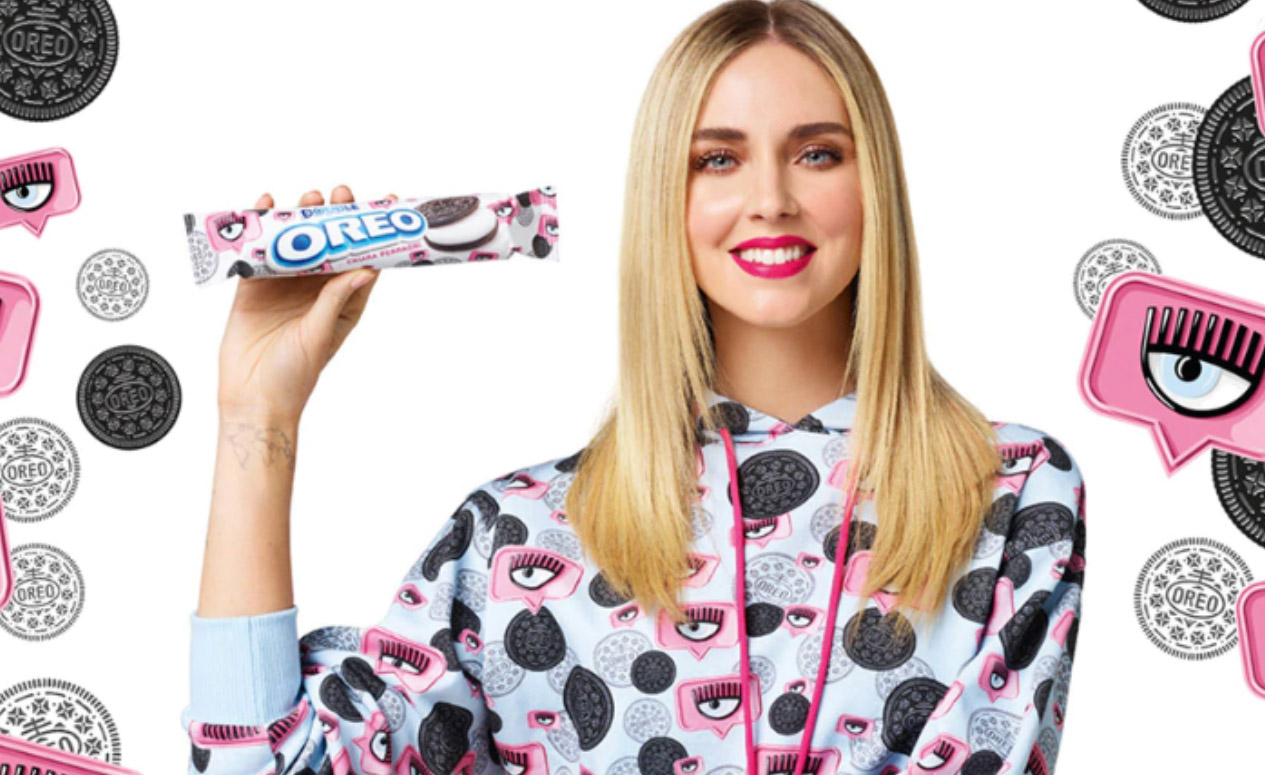 Source: The Blonde Salad[/caption]
In addition to working with other brands to promote products, some influencers have leveraged their popularity to create and sell their own brand—a trend that we expect to continue. One of America’s most famous influencers, Kim Kardashian, created a shapewear and solutionswear brand, Skims, on September 10, 2019. The brand has its own social media marketing accounts, and Kardashian also uses her personal accounts to promote the brand; she has over 180 million followers on social media. Kardashian has 1.8 million followers on Instagram, and her posts often draw attention from audiences—for example, one recent post about Skims’ sleepwear and loungewear on June 24, 2020 had gained around 3.2 million likes as of July 23.
[caption id="attachment_113307" align="aligncenter" width="700"]
Source: The Blonde Salad[/caption]
In addition to working with other brands to promote products, some influencers have leveraged their popularity to create and sell their own brand—a trend that we expect to continue. One of America’s most famous influencers, Kim Kardashian, created a shapewear and solutionswear brand, Skims, on September 10, 2019. The brand has its own social media marketing accounts, and Kardashian also uses her personal accounts to promote the brand; she has over 180 million followers on social media. Kardashian has 1.8 million followers on Instagram, and her posts often draw attention from audiences—for example, one recent post about Skims’ sleepwear and loungewear on June 24, 2020 had gained around 3.2 million likes as of July 23.
[caption id="attachment_113307" align="aligncenter" width="700"] Source: Kim Kardashian Instagram[/caption]
The brand seems unable to fulfill demand due to high volume, demonstrating its popularity. On its website, most items are frequently out of stock, and the company drops new products in new fabrications nearly weekly. The marketing is modern, vintage, monochromatic and technical all at once, and it is powered by the Kardashian family of influencers—Kim and her sisters—which has helped to generate interest and buzz to the entire category of shapewear.
[caption id="attachment_113308" align="aligncenter" width="700"]
Source: Kim Kardashian Instagram[/caption]
The brand seems unable to fulfill demand due to high volume, demonstrating its popularity. On its website, most items are frequently out of stock, and the company drops new products in new fabrications nearly weekly. The marketing is modern, vintage, monochromatic and technical all at once, and it is powered by the Kardashian family of influencers—Kim and her sisters—which has helped to generate interest and buzz to the entire category of shapewear.
[caption id="attachment_113308" align="aligncenter" width="700"]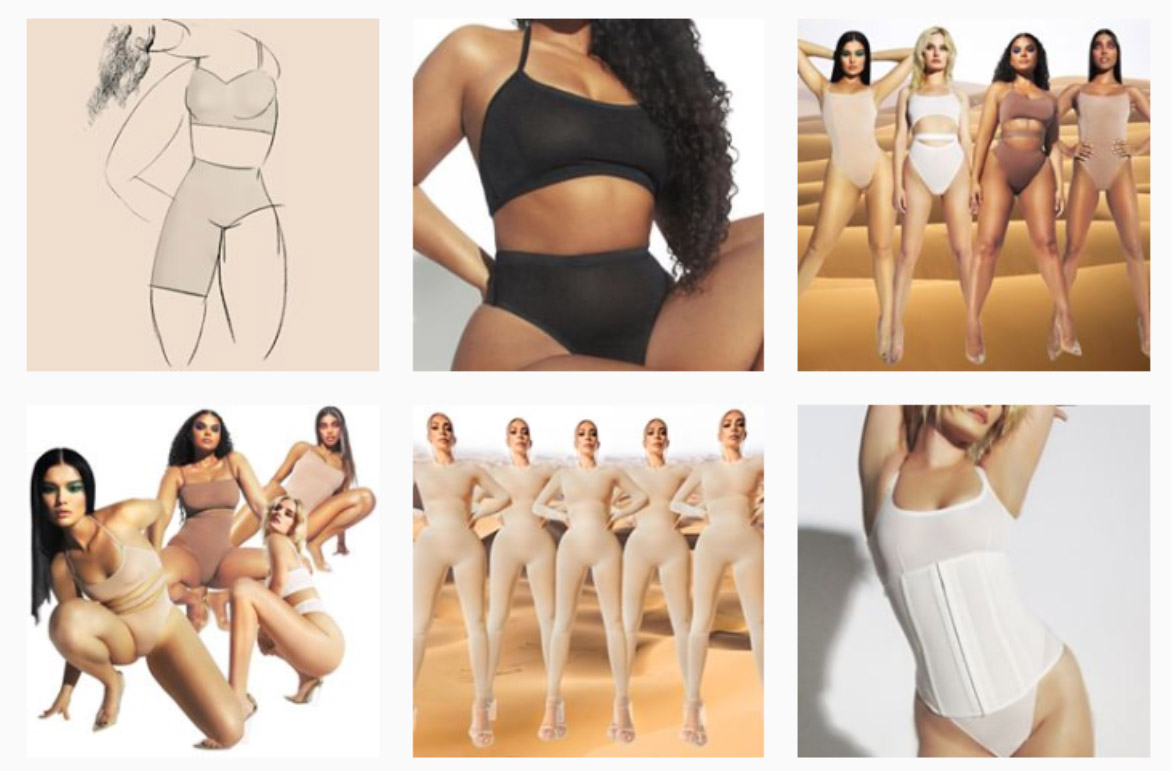 Source: Skims Instagram[/caption]
Source: Skims Instagram[/caption]
Social Media Marketing amid the Crisis
Social media became a key digital tool for brands and retailers to connect with consumers during the coronavirus pandemic and associated retail shutdowns. Companies creatively used social media as a channel in which consumers could discover and experience their products. Companies Innovatively Sell Products through Virtual Happy Hours Virtual parties have become popular on social apps such as Facebook Live, FaceTime, Google Hangouts and Zoom, as people have been discouraged from leaving their homes or gathering in large groups because of the coronavirus pandemic. Haus, a direct-to-consumer brand that sells aperitifs, launched virtual happy hours to sell products. The company invited consumers to join happy hours on Instagram Live, promoting the events through other social media channels such as Twitter. [caption id="attachment_113309" align="aligncenter" width="700"] Source: Haus Twitter[/caption]
Robert Mondavi, a leading American winemaker, launched a series of virtual cocktail parties. Consumers could enjoy virtual, guided tasting sessions and tours.
[caption id="attachment_113310" align="aligncenter" width="700"]
Source: Haus Twitter[/caption]
Robert Mondavi, a leading American winemaker, launched a series of virtual cocktail parties. Consumers could enjoy virtual, guided tasting sessions and tours.
[caption id="attachment_113310" align="aligncenter" width="700"] Robert Mondavi’s virtual happy hour with Giant BBQ Battle, a food & music festival organizer
Robert Mondavi’s virtual happy hour with Giant BBQ Battle, a food & music festival organizer Source: Giant BBQ Battle Twitter [/caption] Beauty and Active Brands Promote Products via Alternative Content on Social Media Beauty brands and retailers have found creative ways to market their products on social media, emphasizing eye-makeup products due to the proliferation of face masks. In China, cosmetics brands invited KOLs to advertise their products. On Chinese social media platform Weibo, KOLs shared content with the hashtag #MustHavesForFaceMaskMakeup, which focused mostly on eyeshadow, eyeliner and mascara. The hashtag saw over 47,000 posts and was viewed more than 100 million times between late January and late April 2020. Similar hashtags were also common on other Chinese social media platforms, such as Douyin and Little Red Book. These social media campaigns successfully translated into sales: Tmall Global, Alibaba’s cross-border e-commerce platform, reported a 40% year-over-year increase in eyeshadow sales during the first quarter of 2020. [caption id="attachment_113311" align="aligncenter" width="700"]
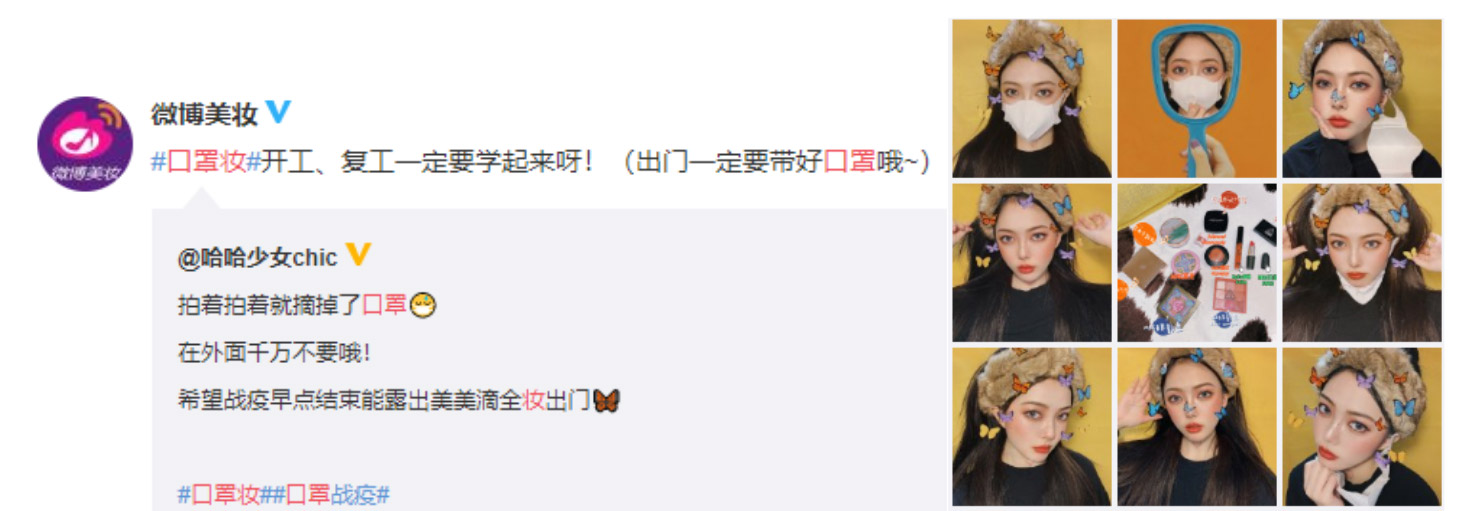 Chic, a KOL in China, shared her eye-makeup looks
Chic, a KOL in China, shared her eye-makeup looks Source: Weibo [/caption] Two activewear companies, Lululemon and NIKE, stayed engaged with their customers through the coronavirus crisis by leveraging social media to offer free exercise classes and encourage at-home workouts. NIKE reported that the strong engagement of Chinese consumers translated into 30% digital commerce growth for the company. On Instagram, Lululemon began offering online “sweat sessions” for yoga, meditation, Pilates, dance and other training exercises. During the first week of store closures in the US, 170,000 viewers joined the company’s live classes. [caption id="attachment_113312" align="aligncenter" width="700"]
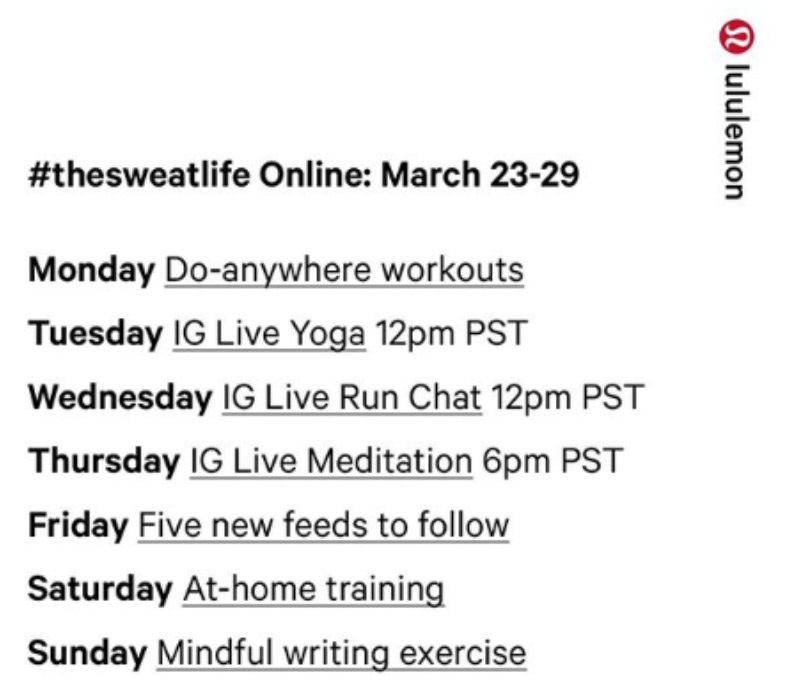 Source: Lululemon Instagram[/caption]
Source: Lululemon Instagram[/caption]
What We Think
Social media will continue to play an important role for companies to market and sell products, as more and more consumers use social media to stay informed and connected in the wake of the pandemic. Retailers and brands need to leverage this opportunity to adjust their social media strategies and engage with consumers as well as marketing their products. Implications for Brands and Retailers Brands and retailers should look to provide seamless and customized shopping experiences via social media, which they can do in different ways:- Partner with social media platforms that have “shoppability” to drive conversion from clickable content.
- Increase social media influencer marketing budgets to drive engagement with consumers and impact purchasing decisions.
- Create alternative content, such as virtual events, to differentiate from competition and increase consumer interest in the brand.